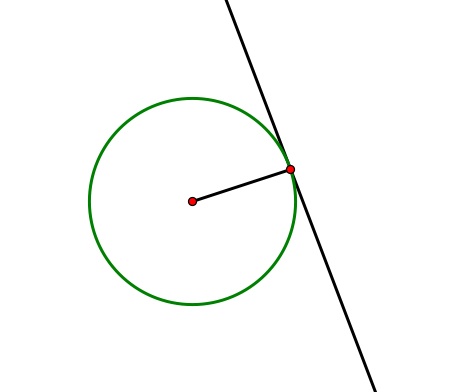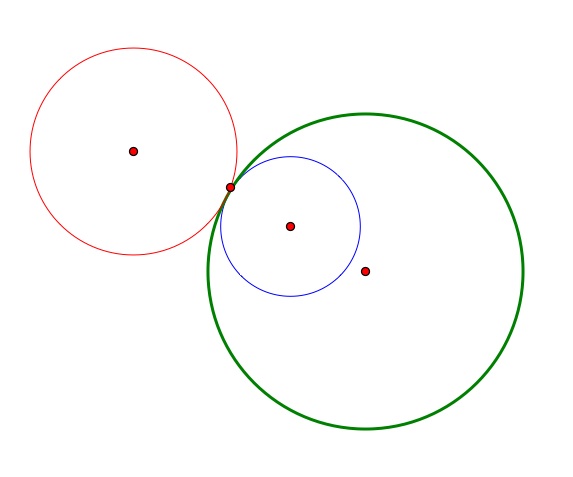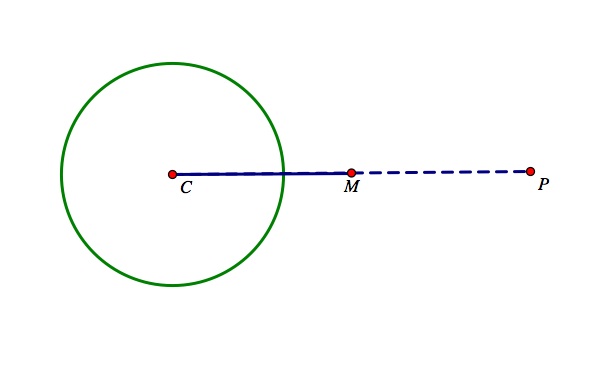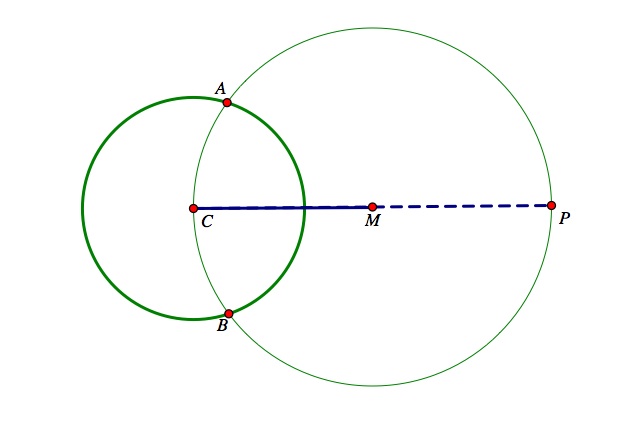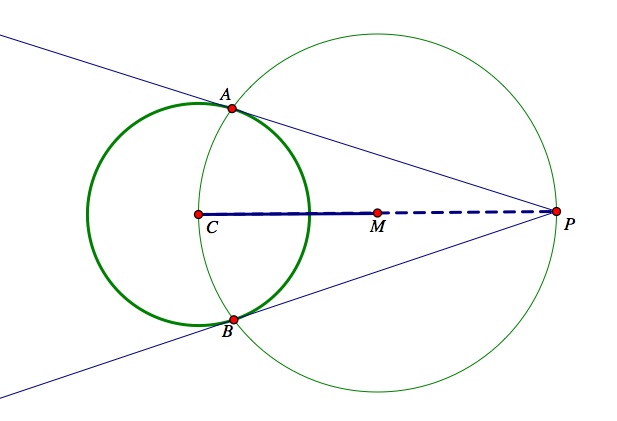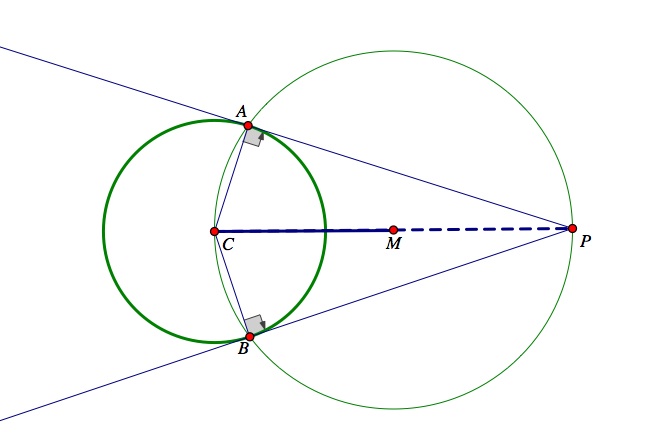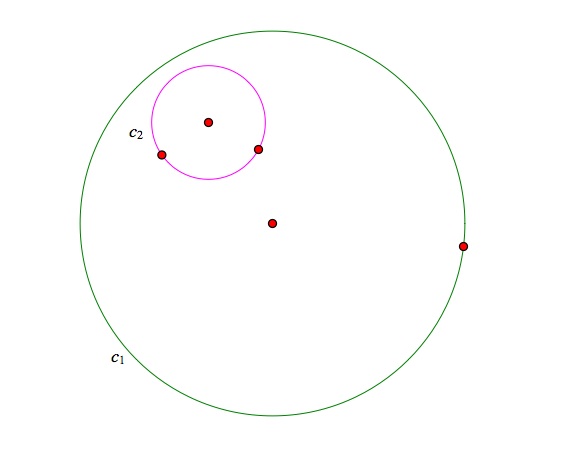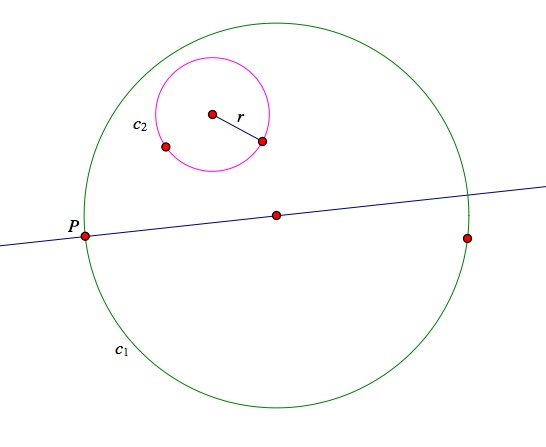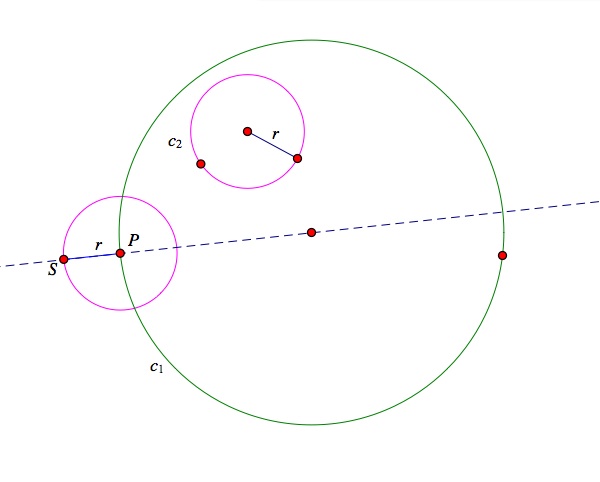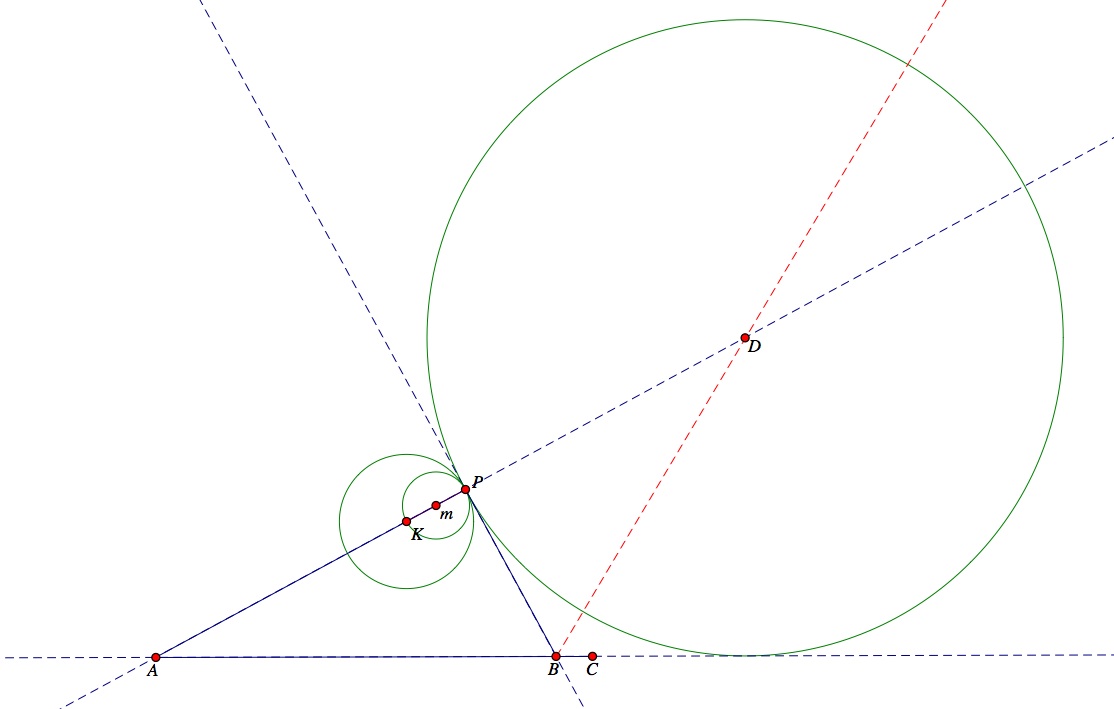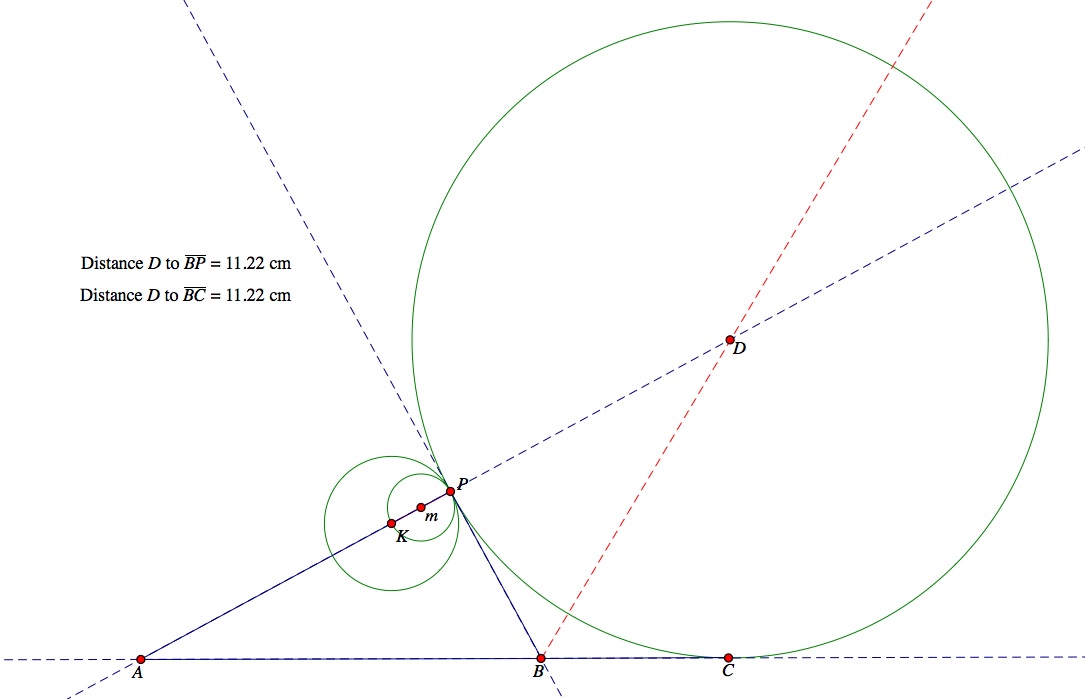Assignment 7
Tangent Circles
Nicolina Scarpelli
Background Information
A circle is a set of points which are all a certain distance from a fixed point known as the center. A line joining the center of a circle to any of the points on the circle is known as a radius. Now we must define what tangent means. A straight line or plane is said to be tangent if it touches a curve or curved surface at a point but does not intersect it at that point. In this investigation, a line is tangent to a circle if it touches the circle at just one point, this is shown below.
If the line intersects the circle it is not considered a tangent line. Since a tangent line only touches the circle at exactly one point, that point must be perpendicular to the radius of the circle. The point where the tangent line and the circle touch is called the point of tangency.
A line is not the only thing that can be tangent to a circle. A circle can be tangent to another circle as well. The circle that is tangent to an original circle can be located inside or outside the original circle. Observe the picture below with the green circle being the original circle. The red circle is a circle located outside the green one and tangent to the green circle, and the blue circle is a circle located inside the green one and tangent to the green circle.
Investigation 1: Construct a tangent to a circle from a point not on the circle.
We will begin first by constructing an arbitrary circle, label it C. Then, locate a point not on the circle and label it P.
Then, construct a segment to connect CP. Find the midpoint of the segment CP and label it M. Then select the points C and M and create a segment from C to M.
Select the segment CM and the point M, and use the circle by center and radius to construct a circle M with radius CM. Label the intersections with circle C as points A and B.
Then, construct a ray through the points P and A, and also construct a ray through the points P and B to get the picture below.
As you can see from the sketch above, segment AP and segment BP are tangents. Now, are these really tangents? We can prove they are tangents by drawing a segment from C to A and from C to B. Angle CAP and angle CBP are right angles because an angle inscribed in a semi - circle is a right angle. Observe the sketch below.
Notice that angle CAP and angle CBP are right angles, this means that the segment PA is perpendicular to the radius CA in the circle C and the segment PB is perpendicular to the radius CB in the circle C. Since the segments PA and PB are perpendicular to the radii CA and CB at the point of contact on circle C, segments PA and PB are tangents to the circle C.
To further confirm that segments PA and PB are tangents to the circle C, we know that the angle inscribed in a semi- circle is 1/2 the measure of the arc it subtends, so the length of the semi-circle CP is equal to 180 degrees. Therefore, segment CP must be the diameter of a circle that passes through the points of tangency, A and B. Repeating the steps above, and using the midpoint, m, of segment CP as the center and a radius equal to MP, a circle is constructed. Where this circle intersects the first circle are the points of tangency (labeled A and B). These points can now be connected to point P thus forming the tangent lines. Therefore, segment PA and segment PB are tangent lines to the circle C.
Click here for a GSP construction.
Investigation 2: Given two circles and a point on one of the circles. Construct a circle tangent to the two circles with one point of tangency being the designated point.
Let's begin this investigation by constructing two arbitrary circles, and have one circle located inside the other. Label these two circles, c1 and c2.
Next, construct the radius of c2 (shown in pink) by creating a line segment between the center and a point on the circle. Then, construct a point on c1 (shown in green), label this point P, and make a line through the point P and the center of c1. The resulting image should look like the image below.
Now, let's construct a circle with a center point P and radius equal to the radius of the smaller pink circle c2. In order to have the radii equal each other, click on the point P and click on the line segment (radius) of c2. Go to construct circle by center and radius, and a new circle should appear centered at point P with radius equal to the radius of the smaller circle. Construct the intersection point, S, which is the intersection of the new circle centered at P and the line crossing through P and the center of c1.
Now, construct a line segment from the center of c2 to the intersection point S. Construct the midpoint, m, of the segment by clicking on the segment and going to construct midpoint. Then, click on the midpoint and the segment and go to construct perpendicular line. You have now constructed the perpendicular bisector of the line segment. Label the intersection of the perpendicular bisector and the line through the center of c1 and the point P, A. Observe that the point A is equidistant from point S and from the center of c2.
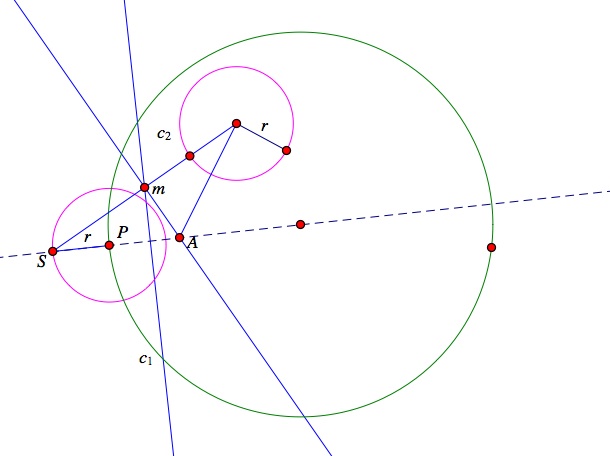
Now, construct a circle by center and point with A being the center and P being the point. The newly created circle (shown in black) is now tangent to both circles, c1 and c2.
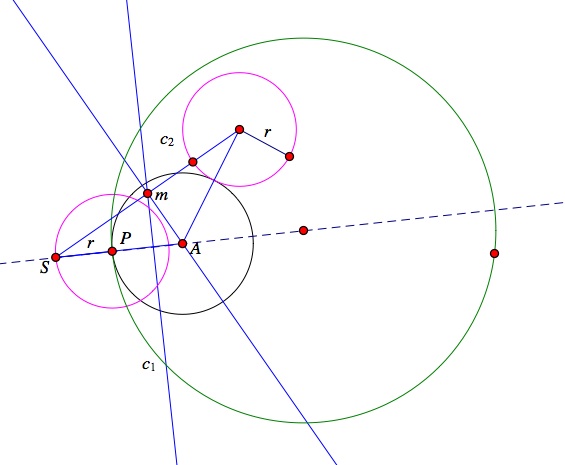
Now, construct a midpoint of the segment from the the center of circle c2 and the point A. Then, construct the perpendicular bisector of this segment through the midpoint. Now, construct the intersection point of the perpendicular bisector and the dashed line through the center of c1. This intersection point is the center of another circle that is tangent to the point P. Thus, double click on this new point, and click on the point P, and construct a circle by center and point. Label the center of this new circle B.
Observe the final image below and click here for the GSP construction. Notice we constructed a circle centered at A(shown in black), and constructed a circle centered at B (shown in red), both tangent to circle c1 and tangent to circle c2 with one point of tangency, P.
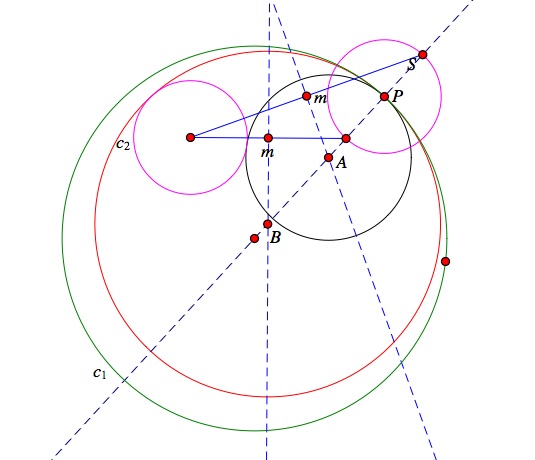
Investigation 3: Given a line and a circle with center K. Take an arbitrary point P on the circle. Construct two circles tangent to the given circle at P and tangent to the line. This case of the line and a circle might be considered the limiting case of the two disjoint circles. The line is in some sense a circle with an infinite radius. This is because, a circle with radius , r , whose center is at (r, 0) has the parametric form x = r ( 1 - cos(θ/r)) and y = r sin(θ/r)). As r approaches infinity the limit of the parametric curve is x = 0 and y = 0. Therefore, you will have a line.
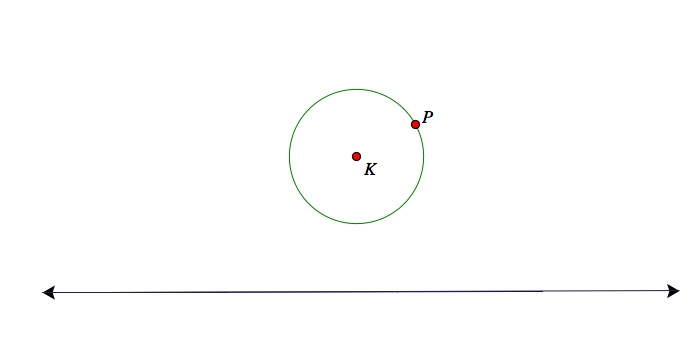
Let's begin this investigation by constructing a perpendicular line through point P with radius K. To do this, construct a line segment from point P to the center K, this will be the radius K. Then, click on the point P and click on the line segment, and go to construct perpendicular line. We must do this in order to create a point of tangency on the circle with center K.
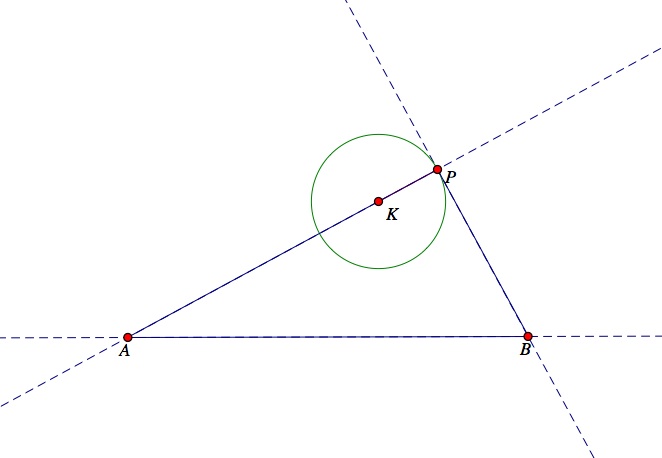
Now, there are a few ways to create tangent circles. I created a tangent circle by constructing the midpoint of the radius. Thus, construct the midpoint, m, of the segment KP and then construct a circle by center and point with the midpoint being the center and P being the point. Observe that the newly created circle with center, m, is tangent to the circle centered at K.
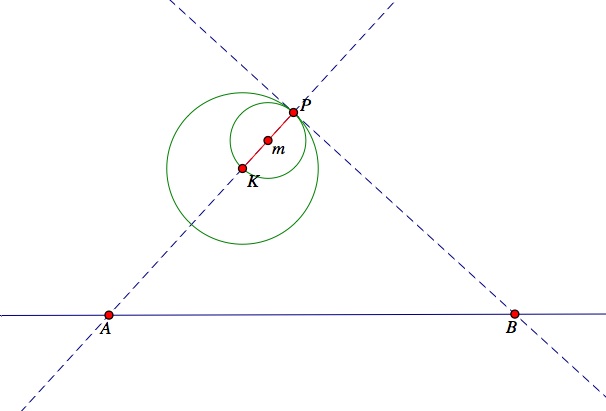
Now, let's plot an arbitrary point C on the original line. In order to find the other tangent circle we must construct the angle bisector of angle PBC and apply the angle bisector theorem. The angle bisector is the line segment that divides the angle into two equal parts. We want the second circle to be tangent to the original line AB and tangent to the circle centered at K at point P as well. Therefore, the center of the second tangent circle must be equidistant from the sides of angle PBC. This will only happen if its center is located on the angle bisector of angle PBC, because according to the angle bisector theorem, the angle bisector in a triangle divides the opposite side in the same ratio as the sides adjacent to the angle. Now the second tangent circle can be constructed using the intersection of line AP with the angle bisector as its center. This intersection point is labeled D. Construct the new circle by center and point with D being the center and P being the point. Observe the image below.

